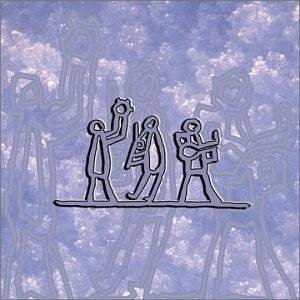 This is the album that got the Hedningarna phenomenon going, a richly textured, darkly fascinating instrumental album by the “core” trio of Björn Tollin (frame drum, string drum, hurdy-gurdy, moraharpa), Anders Norudde (fiddle, hardanger fiddle, moraharpa, swedish bagpipe, bowed harp, jews harp, wooden and pvc bass flutes) and Hållbus Totte Mattsson (lute, baroque guitar, hurdy gurdy). On more recent albums, the group has expanded to include other players and some dynamite vocalists, most recently exploring the roots of Swedish folk traditions in Russia on Karelia Visa.
This is the album that got the Hedningarna phenomenon going, a richly textured, darkly fascinating instrumental album by the “core” trio of Björn Tollin (frame drum, string drum, hurdy-gurdy, moraharpa), Anders Norudde (fiddle, hardanger fiddle, moraharpa, swedish bagpipe, bowed harp, jews harp, wooden and pvc bass flutes) and Hållbus Totte Mattsson (lute, baroque guitar, hurdy gurdy). On more recent albums, the group has expanded to include other players and some dynamite vocalists, most recently exploring the roots of Swedish folk traditions in Russia on Karelia Visa.
This Northside re-release brings a stunning album to North American audiences for fans who’ve liked the more recent discs and want more. As you may suspect, dear reader, I’m about to go into paroxysms of enthusiasm for the band and for this disc; in other words one of my gushing rants of extravagant praise. Please be assured that it is deserved. There is real magic here, made through a finely tuned sense of the way these traditional instruments should fit together with the tunes.
The album opens with “Polska after Pele Fors,” a traditional with roots in an older era, an exotic, yet stately song played with what sounds like restrained passion — dramatic and slightly dissonant. Hedningarna continues on, combining Norudde’s originals with traditional numbers, without a missed step or a clunker on the disc. This is truly impressive for a debut, and it sounds as compelling now as in 1989. It is difficult to pick favorites, because they are all good. There is also a good balance between the wind and stringed instruments on melody, giving the disc a good flow across the tunes.
“Multihalling,” a Norudde original, contains a great sense of a lilting conversation between the dark tones of the fiddle and one of the lower stringed instruments, guitar and frame drum — I’m guessing here because the tracks do not have detailed information about instrumental arrangements. It pairs stringed instruments in melodic exchanges, along with minimal, but effective, rhythm and percussion. The result is something that sounds at once ancient and experimental. I hesitate to use the world music moniker here, with the associations of heavy percussion and over-obvious synthesis. But it is apparent that Hedningarna have a deft sense of how to make their material seem fresh, interesting and yet unmistakably drawn from an old musical substrate — bedrock even. The wails of the strings, the way the flutes slip between notes, the subtle rhythm and the exotic sounds of the bagpipe and hurdy gurdy show why Hedningarna has since become something of a phenomenon.
“Doplåten / The baptism Tune”, another original, is reminiscent of something klezmorim might have played in the last century, yet it satisfies today’s listener with the deft percussion that keeps up a tension around the melody, building to a slow climax. The other standout is a traditional entitled “Särna Galma Brudmarsch / Old Särna Wedding March,” which features a wailing melodic line on bagpipe that seems to hail from points deep in the heart of Asia. It’s slow and not entirely happy (one doesn’t know what to think of this wedding), reminding us that every new beginning is also an end to something as well. There are also several great wooden flute interludes that wail quietly, with that lonesome sound only the flute can make. At the risk of totally abusing imagery, in the introduction of “Fulinghalling / Scamphalling” I had the sense that the North American flute-playing deity Kokopelli had somehow become misplaced and was searching for his desert home, playing an eerie whistle tune while a low drone provided a sense of the wind blowing him around.
This is a not a fast and loud album, instead creating its sense of mystery at a deliberate pace that combines tension and grace. It’s great music for keeping the mind active — it never quite lets you go as you listen, but it doesn’t force anything either. Norudde is a great composer who captures an old soul in his original tunes, while making music that is very accessible to contemporary sensibilities.
(Alice Musik, 1989; reissued by Northside, 2001)
